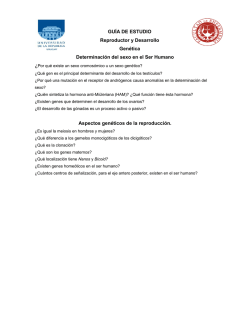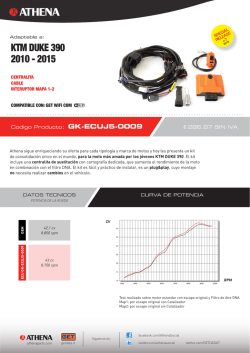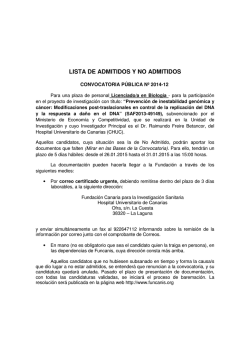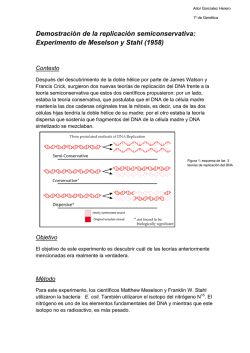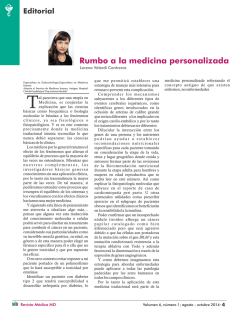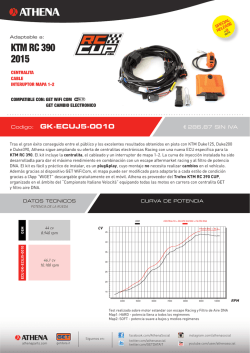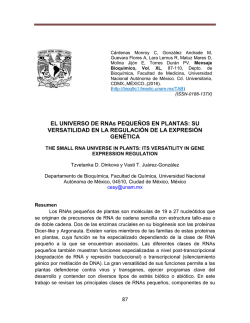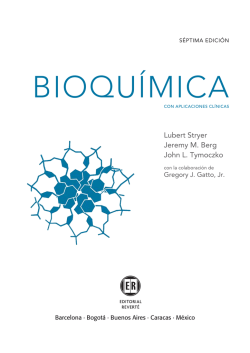
Clase_16-1 - Traduccion
Organización y Regulación del genoma de plantas Paris japonica Amborella trichopoda Picea abies Arabidopsis thaliana Zea mays Blog: hKp://www.traduccionbm.wordpress.com Dra. Tzvetanka D. Dinkova Depto. Bioquímica, Facultad de Química Conjunto E, Lab. 103 [email protected]; [email protected] Es7mación del tamaño de genomas mamíferos plantas hongos bacterias mitocondriales virus 1e1 1e2 1e3 Tamaño en nucleóPdos. 1e4 1e5 1e6 1e7 1e8 1e9 1e10 1e11 1e12 Tamaño del genoma nuclear de algunas plantas (Mbp) Paris japonica Picea abies 150,000 20,000 Genoma nuclear en plantas Se localiza en cromosomas Baja densidad de genes 27,206 genes para proteínas en Arabidopsis Secuencias repetidas Número de cromosomas variable (algunas especies tienen más de 200) • Frecuentes Aneuploidías y Poliploidías (Angiospermas) • • • • • Organización del genoma nuclear Telómero Centrómero Telómero Centrómero: • Secuencia de DNA que recluta a proteínas del cinetocoro y a los microtúbulos durante la mitosis. • Secuencias y extensión variable entre especies • Contiene repetidas, en tandem o aisladas, retrotransposones, DNA satélite • En plantas, esta región se puede transcribir por la presencia de retrotransposones Telomeros: • Extremos del cromosoma; estabilización • Extensión 2 – 75 kb (heptanucleótido repetido) • Telomerasa ausente en tejidos vegetativos, se expresa en meristemos, floración y en cultivo de tejidos in vitro Cromosomas Short arm Organ Long arm Chromatid Chromatid Telomere NOR secondary constriction Chromosome regions: Centromere primary constriction Pericentric (pericentromeric) paracentric (paracentromeric) Telomere Intercalary interstitial Subtelomeric terminal Cambios cromosómicos Relocalización de material genéPco Pérdida de material genéPco Ganancia de material genéPco Evolution of the A. thaliana (n = 5) karyotype based on comparative chromosome painting in A. lyrata (n = 8). Martin A. Lysak et al. PNAS 2006;103:5224-5229 Alteraciones numéricas cromosomales Fenotipos en plantas de maíz con trisomía en el brazo corto del cromosoma 5 Makarevitch et al., 2008 Autopoliploidía Alopoliploidía Duplicaciones en la evolución de plantas Plant Genome Duplica0on Database Diploid: 2!7 Diploid: 2!7 Triticum monococcum (2n =14) AA Triticum searsii (2n =14) BB Generación del trigo hexaploide moderno Sterile hybrid (1n =14) AB Chromosome doubling Tetraploid: 4!7 Triticum turgidum (2n =28) AABB Diploid: 2!7 Triticum tauschii (2n =14) CC Sterile hybrid(1n =21) ABC Chromosome doubling Hexaploid: 6!7 Triticum aestivum (2n =42) AABBCC Plant Genomics Vigor de genomas híbridos Genoma mitocondrial en plantas Cromosomas circulares Genomas multipartitas Tamaño 200 a 2,500 kb Codifica rRNA, tRNA, proteínas cadena respiratoria. • La mayor parte de proteínas mitocondriales codificada en núcleo. • Flujo de DNA entre Mt, Cp y Nu • Muchos ORFs de función desconocida • • • • Transferencia de secuencias entre los genomas celulares Tamaños de genoma mitocondrial en plantas trends in plant science Clasificación de secuencias en el genoma reviews mitocondrial Other repeats Intron sequences 3.9% 8.8% Plastid origin 1.2% Nuclear nuc — mt Recombinative origin homologies repeats 2.2% 2.9% 4.0% Protein coding genes 16.1% rRNAs 1.3% orfs >100 aa tRNAs 10.2% 0.4% 49% unaccounted for Trends in Plant Science Fig. 1. Genome sequences in Arabidopsis. To date, half of the mitochondrial genome sequences in Arabidopsis are accounted for. Some of the nuclear–mitochondrial homologies are probably sequence transfers from the mitochondrial genome to the nucleus. Duplications of sequences listed in two categories of repeats might cover parts of genes or total genes. Intron sequences exclusively belonging to ge to an fro of Co tra re th its pl tra as m in In ge th m ge du Dramá7ca expansión del genoma mitocondrial en el género Silene Enormous Fast-Evolving Plant Mitochondrial Genomes Figure 8. Silene mitochondrial genome sizes relative to all sequenced mitochondrial and eubacterial genomes from the National Center for Biotechnology Information (NCBI) Genome database. doi:10.1371/journal.pbio.1001241.g008 do not include chromosomes in S. noctiflora and S. conica that only contain partial gene fragments that require trans-splicing with transcripts originating from other chromosomes to generate Sloan et athe l., 2functional 012 PloS Biology complete coding sequences). Therefore, significance (if any) of these ‘‘empty’’ chromosomes and the evolutionary forces that maintain their presence and abundance within the mito- efficacy of selection against the proliferation of noncoding elements even if the intensity of that selection has increased with higher mutation rates. There is some evidence to support this possibility, particularly in S. noctiflora, which appears to have a very low Ne based on the striking lack of polymorphism in genes from all three genomes (Table S3) [49]. However, the finding of high Genoma de cloroplasto Múltiples moléculas circulares Tamaño 120 – 160 kb Similar al DNA mitocondrial Codifica rRNA, proteínas involucradas en transcripción/traducción, fotosíntesis y transporte de electrones • Intrones, repetidas invertidas • Asociación con proteínas remodeladoras • • • • Organización del genoma de cloroplasto wikrowska et al. Plastid nucleoids • El DNA se asocia con la membrana • Aumenta el número de nucleoides durante el desarrollo y se unen proteínas que ayudan a compactar el DNA • Papel de las proteínas asociadas en replicación, transcripción y reparación Powikrowska et al. Plastid nucleoids FIGURE 1 | Visualization of plastid nucleoids by using different chloroplasts. (C) Specimen prepared by high pressure freezing and freeze microscopic techniques. (A) Nucleoids visualized by fluorescence substitution (HPF-FS). (D) Immunogold labeling of nucleoids in leaf sections microscopy of SYBR Green in leaf sections, bar: 10 µm. (B) Conventional obtained from specimen prepared by high pressure freezing and freeze Powikrowska et al., 2014 Fron0ers in Plant Science electron micrographs showing nucleoids with DNA filaments in mesophyll substitution (HPF-FS) using a DNA specific antibody, bar: 500 nm. possess thylakoids but lack grana stacks and are devoid photosynthetic complexes resulting in compromised thesis (Luo et al., 2013). Taken together, these studies state of the photosynthetic apparatus (Pfannschmidt et Thereby the composition of the photosynthetic appa continuously be adjusted to the ever changing envir 3 | Nucleoid organization during chloroplast development. besides a green containing chloroplasts. Chloroplasts wer Powikrowska et apart l., 2014 Fron0ers in Plant Science Reestructuración del genoma del cloroplasto Clasificación de genes Genes que codifican proteínas RNA mensajero Genes nocodificantes RNA estructural y otro Proteínas Proteínas estructurales Región intergénica RNA de transferencia Enzimas RNA ribosomal Otro RNA Genes duplicados • Codifican proteínas relacionadas • Familias mulPgénicas frecuentes en plantas • Neo-‐ o sub-‐funcionalización, silenciamiento Pseudogenes • Son copias no funcionales de genes • No se expresan por mutaciones sin senPdo, falta de secuencias reguladoras o problemas en procesamiento de RNA DNA repe77vo • Secuencias moderadamente repePdas – Función conocida (proteínas, tRNA, rRNA) – Función desconocida • SINEs (short interspersed elements) – 200-‐300 bp – 100,000 copias • LINEs (long interspersed elements) – 1-‐5 kb – 10-‐10,000 copias • Secuencias altamente repePdas – Transposones – Pericentroméricas y Centroméricas – Telómeros ant Organización de secuencias repe7das Simple tandem array Transposable element h- antities of heir needs function. ll percentlly encode uction of e genome ranscribed low-copyDNA segenes are umbers of on with so into the st of these noncoding Repeat/single-copy interspersion Single-copy gene Inverted repeats Compound tandem array Repeat/repeat interspersion (a) Different arrangements of repeated and inverted DNA sequences (b) Transposable element excision and reinsertion FIGURE 43.4 Organization of repeated DNA sequences and the mechanism of transposable criteria, equire a can be at the oteins ack the plicative Type I — Retrotransposons LTR Non-LTR LTR gag pol 5′ UTR orf1 orf2 LTR Transposones (TE) AAAAAAA , step to sposase out of te. The nt on by ently, Type II — DNA transposons Autonomous TIR Transposase TIR Non-autonomous Mutation derivative Transposase TIR TIR Barbara Mc Clintock, 1951 A- ers, but ts. Nonnsposon nally, n. e he Alu on-LTR TIRs conserved TIR MITE TIR TIR TIR Autonomous helitron Replicase Helicase Slotkin & Mar7enssen, 2007 Contribución de los TE al tamaño de los genomas s: Biology and Evolution 27 . ), a 28 E. Kejnovsky et al. a Relative contribution of main groups of TEs to genome coverge in various plants (species arrayed according to genome size) Arabidopsis thaliana Fragaria vesca Cucumis sativus Oryza sativa Lotus japonicus Populus trichocarpa Vitis vinifera Brassica oleracea ) omes, while copia-like elements n species with smaller genomes timescales (Bennetzen 2005). One of the best-known examples in plants comes from maize, where repeated bursts of retrotransposon amplification over the past 6 million years g closely related species or even have been responsible for generating approximately half of mily may also differ substantially, the modern maize genome (SanMiguel et al. 1998; Walbot Sorghum bicolor Glycine max Zea mays Gossypium raimondii e is often a direct reflection of a and Petrov 2001). Similarly, a three-fold increase in the TE families that have undergone genome size of diploid members of Gossypium is due to the n are usually absent among closely accumulation of LTR retrotransposons over the past es that have undergone amplifica- 5–10 Myr (Hawkins et al. 2006). In Oryza australiensis, ints can be shared among closely three LTR retrotransposon families proliferated during the duct of their shared evolutionary last 3 million years leading to a two-fold increase in genome e former was demonstrated via size compared to that of Oryza sativa (Piegu et al. 2006). The Kejnowski t al., 2012 higher copy number of TEs in Arabidopsis among wheat and barley, where etwoto threefold undant in one species were virtu- lyrata compared to A. thaliana correlate and may be attributed Relative coby numbers of main groups of TEs in various plant genomes (species arrayed according to genome size) b tive (Wicker et al. 2009). The rate to the higher expression of TEs in A. lyrata, apparently caused Arabidopsis Cucumis sativus Oryza sativa Fragaria vesca ar (through either vertical or hori- by less efficient TE silencing in this species (Hollisterthaliana et al. LTR non-LTR DNA TE Helitrons Ac7vidad de Transposones Retrotransposones Transposones de ADN Los transposones pueden causar reordenamientos y cambios en los genomas Dinámica de los genomas Transposones Transferencia de DNA Duplicación de DNA Los Virus Evolución de genomas Regulación Epigenética EUCROMATINA • • • • • Poco condensada Distribuida a lo largo del cromosoma Rica en genes Rápida replicación Recombinación en Meiosis HETEROCROMATINA • • • • • • Altamente condensada Centrómeros y telómeros Rica en secuencias repePdas Pobre en genes Se replica tardíamente No sufre recombinación meióPca Epigenética: cambios reversibles y heredables en la expresión genética que no implican cambios en la secuencia de DNA! ! Herencia Epigenética: transferencia de información diferente a la secuencia de DNA desde una célula progenitora a células hijas! ! Información Epigenética: se almacena como metilación de DNA y marcas de histonas. ! ! ! Relevancia de algunas modificaciones de H3 La tri-metilación de K9 y K27 son marcas de silenciamiento asociadas a metilación del DNA La tri-metilación de K4 es una marca asociada a genes transcripcionalmente activos La metilación de K36 parece tener rol represivo o de activación dependiendo del contexto nloaded from www.annualreviews.org 9/23/11. For personal use only. ANRV410-PP61-17 ARI 4 May 2010 15:12 Función de las marcas de Histonas Lys9 Impresión (K9), Lys27 (K27), Lys36 (K36) of de la and marca: histone These modifications written (específicas) - H3. Metil transferasas de are Histonas by different histone lysine methyltransferases - Acetlilasas de Histonas Writer: an enz (HKMTs) (Table 1). In contrast to mammals that is responsib - Otros and yeast, in which Lys20 (K20) of histone adding a Writer Eraser Reversible H4 (H4K20) is methylated, H4K20 is acety- posttranslationa lated in Arabidopsis, though mono-methylated modification(s) given protein (e H4K20 (H4K20me1) has been reported to be HKMT) detected by immunostaining (94). Another difReader: a prot ference is the lack of an Arabidopsis homolog protein comple of DOT1, an H3 lysine 79 (H3K79) methyl- recognizes and transferase required for telomeric silencing in specifically to a mammals and yeast; nor is any H3K79 methy- particular lationLectura detected de (147). addition, Arabidopsis posttranslationa la In marca: modified substr and rice were shown to have much higher lev- Remodeladores de cromatina els of H3K4 di-methylation (H3K4me2) than Eraser: an enz - Factores de transcripción that removes a mouse and human, and Arabidopsis has much posttranslationa - Metilasas de DNA lower H3K9me2 and H3K9me3 levels (42, 47). modification(s) Reader These results indicate that global histone mod- given protein (e ification levels and patterns in Arabidopsis and HDM) Figure 1 rice are quite different from those in mam- HKMT: histon Schematic representation of the processes of mals, possibly reflecting differences in genome lysine writing, reading, and erasing the histone Liu et amethyltransfera l., 2010 composition. posttranslational modifications. Writer enzymes add Control epigenético de floración FLC – represor floral Tritorax Polycomb Metilación del DNA Metilación*DNA A.#thaliana Simétrica*/* de*mantenimiento % Aproximado de TEs en Genomas de plantas Asimétrica*/* de#novo 90 80 CHG 70 CHH 60 % CG 24.0*% **6.7*% 1.7*% MET1 CMT3 DRM2 RdDM Law & Jacobsen, 2010 50 40 30 20 10 0 Arabidopsis thaliana Oriza sativa Lockton & Gaut, 2009 Zea mays s (DCL2 and d into ARGOArabidopsis), se complexes ever, compelalso be loaded AGO proteins ues) [26–28], nuclear tranads to methycontexts by ases through e methylated nscription, or en transcripshut off [31]. hylation and RNA-directed Metilación del DNA dependiente de RNA Trends in Plant Science May 2014, Vol. 19, No. 5 Inicio (A) AGO1/AGO2 AGO AAAAAA DCL2/DCL4 RDR6 AAAAAA DCL 21/22 nt DCL3 DCL Cytosol Nucleus 24 nt DRM1/DRM2 AGO4/AGO6 DRM TSS Pol II AGO AAAAAA AGO AGO n and ected nerand the AGO s own oblem RNA ction, s [32] ted to close h are se are nsposcriposons th 218], as 9–41]. AAAAAA Metilación del DNA dependiente de RNA Mantenimiento (B) Nucleus DCL3 RDR2 24 nt AGO4/AGO6 VIM1-MET1 TSS Pol IV SHH1 CG DRM1/DRM2 CG Non-CG Non-CG H3K9me2 AGO DRM Pol V AGO KYP-CMT3/CMT2 (C) Kim & Zilberman, 2014 Nucleus hich are hese are transporanscripnsposons with 21[28], as [39–41]. is likely t exhibit hermore, stranded ssed by RNA can dicating egrated. e desired by Pol IV ng DNA ces with ANT IN tebrates) SHH1 AGO Metilación del DNA dependiente de RNA Non-CG H3K9me2 KYP-CMT3/CMT2 Reforzamiento (C) DDM1 VIM1-MET1 VIM Nucleus KYP-CMT3/CMT2 KYP Non-CG MET1 CG H3K9me2 CMT TSS H1 H1 H1 H1 H1 H1 H1 H1 TRENDS in Plant Science Figure 1. Progression of transposon DNA methylation and silencing from Pol IIand RDR6- mediated RdDM (A) to self-reinforcing Pol IV- and Pol V-mediated Paisaje epigenético de A. thaliana The epigenetic landscape of A. thaliana The epigenetic landscape of A. thaliana The relative abundance of genes, repeats, cytosine methylation and siRNAs is shown for the length of A. thaliana chromosome 1, which is ~30 Mb long. The relative abundance of genes, repeats, cytosine methylation and siRNAs is Bottom right: diagram of chromosome, with white bars indicating euchromatic shown for the length of A. thaliana chromosome 1, which is ~30 Mb long. arms, grey bars indicating pericentromeric heterochromatin and the black bar Bottom right: diagram of chromosome, with white bars indicating euchromatic indicating the centromeric core. arms, grey bars indicating pericentromeric heterochromatin and the black bar Henderson & Jacobson, Nature 447, 418 (2007) indicating the centromeric core. Distribución de actividad transcripcional Distribution patterns and transcription activity Distribution patterns and transcription activity detailed distribution detailed distribution patterns and patterns and transcription activity transcription activity (vertical blue bars) in a (vertical blue bars) inenes a a) R egión r ica e n g gene-rich region (top) gene-rich region (top) and a repeat-rich region and a repeat-rich region (bottom). (bottom). Red boxes: genes; Red boxes: genes; Arrows indicate the Arrows indicate the direction of transcription. direction of transcription. b) Región rica en repe7das Zhang, Science 320, 489 (2008) Zhang, Science 320, 489 (2008) Reprogramación epigenética en reproducción REVIEWS A Ba Male gametophyte Tricellular pollen grain St Ov SCs (Silenced transposons) ? 21-nt siRNAs VN (Reactivated transposons) C ? Double fertilization Bb Female gametophyte AC AC AC Endosperm (Hypomethylated) Embryo (Hypermethylated) 2n CCN (Demethylation) Transposon reactivation? siRNAs? ? Reinforced silencing? Syn EC Syn Nature Reviews | Genetics Law & Jacobsen, 2010
© Copyright 2025
